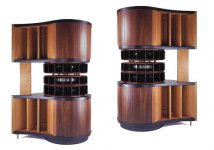AirBlade's range is 1-20kHz.... and they don't say a word of vertical dispersion.
More of BeoLab 5 waveguide here (Sausalito audio lens)
Intro – Sausalito Audio
More of BeoLab 5 waveguide here (Sausalito audio lens)
Intro – Sausalito Audio
Last edited:
Has somebody tried to build a 360 degree multi cell horn consisting of conical flares with a compression driver at the center of the horns both in the top and bottom?
Platinum Audio:
Attachments
How predictable is the “waveguide” on these things? Does it follow a certain mathematical shape? I remember you made a 360 degree paraline (YouTube). Have you ditched that idea? If so, how come?
I made some 3D illustrations to show how the Sausalito Audio Works Lens operates.
They are here : Cloning a $3200 Speaker for $400
In a nutshell, it's a waveguide that's fed by a wavefront that's immediately bent 90 degrees, right at the throat of the waveguide.
That might seem pointless, but it has some advantages:
1) You can get really tight vertical spacing. This is nice for two ways speakers, for instance it's possible to pack your elements in a very tight array vertically. This allows you to control directivity on the horizontal axis with a waveguide, while also allow for the tight spacing that approximates a point source.
2) When you get it JUST RIGHT, a SAW Lens allows you to control directivity all the way up to 20khz. This is a neat trick, because most conventional waveguides have exceptionally narrow beamwidth above 10khz. This is because the wavelengths are so short they don't "see" the walls of the waveguide, the sound just shoots right through the waveguide like a laser beam. Check out the polar response of most waveguides above 10khz, it is very VERY narrow. This is one of the reasons that a lot of waveguide speakers don't have that "sparkle" that you get with a good dome or ribbon. BTW, not all waveguides suffer from this, JBL has a handful that are well behaved out to 20khz but nobody seems to use them.
The Bose Lifestyle 650 satellites appear to be close to omnipoles. Note that their outer width is just 1.84" (47 mm). The drivers are so small that even the vertical dispersion could be good up to 5 kHz, maybe even higher. I think the difficult part of building something like this would be to design the shape of the 'reflector' cones.
(pic taken from HarwareZone.com)
(pic taken from HarwareZone.com)
Attachments
Last edited:
The Bose Lifestyle 650 satellites appear to be close to omnipoles. Note that their outer width is just 1.84" (47 mm). The drivers are so small that even the vertical dispersion could be good up to 5 kHz, maybe even higher. I think the difficult part of building something like this would be to design the shape of the 'reflector' cones.
(pic taken from HarwareZone.com)
Would be interesting to see a picture of the reflector.
- Status
- Not open for further replies.

![bose-lifestyle-650_3[1].jpg](/community/data/attachments/721/721664-bda5e70655a9ea7292561eb5d2bc76c8.jpg?hash=vaXnBlWp6n)